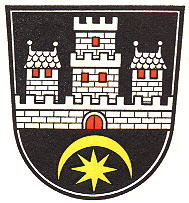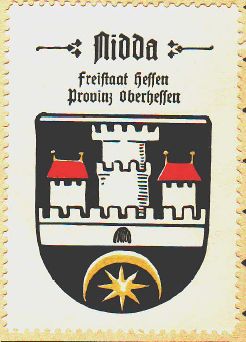Nidda: Difference between revisions
Knorrepoes (talk | contribs) m (Text replacement - "====Official blazon====" to "===Official blazon===") |
Knorrepoes (talk | contribs) m (Text replacement - "====Origin/meaning====" to "===Origin/meaning===") |
||
| Line 12: | Line 12: | ||
(de) | (de) | ||
===Origin/meaning=== | |||
Nidda became a city in 1234 and the oldest seal probably dates from the same time. The seal shows a city wall with towers and a gate. From the 14<sup>th</sup> century onwards, the gate is replaced by the moon and crescent. The colours are known since 1718. The city walls represent the fact that Nidda was a city, the star is taken from the arms of the Lords of [[Ziegenhain]], who owned the city, whereas the crescent may be a typical city or religious symbol. | Nidda became a city in 1234 and the oldest seal probably dates from the same time. The seal shows a city wall with towers and a gate. From the 14<sup>th</sup> century onwards, the gate is replaced by the moon and crescent. The colours are known since 1718. The city walls represent the fact that Nidda was a city, the star is taken from the arms of the Lords of [[Ziegenhain]], who owned the city, whereas the crescent may be a typical city or religious symbol. | ||
Revision as of 06:01, 23 June 2017
This page is part of the German heraldry portal |
Heraldry of the World |
|
German heraldry:
|
Selected collector's items from Germany:
|
NIDDA
State : Hessen
District (Kreis) : Wetteraukreis (until 1972 Büdingen)
Additions : 1970 Bad Salzhausen, Borsdorf, Fauerbach bei Nidda, Geiss-Nidda, Harb, Kohden, Michelnau, Ober lais, Ober Schmitten, Ober Widdersheim, Stornfels, Ulfa, Unter Lais, Unter Schmitten, Wallernhausen; 1971 Schwickartshausen; 1972 Eichelsdorf, Unter-Widdersheim
Official blazon
(de)
Origin/meaning
Nidda became a city in 1234 and the oldest seal probably dates from the same time. The seal shows a city wall with towers and a gate. From the 14th century onwards, the gate is replaced by the moon and crescent. The colours are known since 1718. The city walls represent the fact that Nidda was a city, the star is taken from the arms of the Lords of Ziegenhain, who owned the city, whereas the crescent may be a typical city or religious symbol.
| The arms by Hupp in the Kaffee Hag albums +/- 1925 |
Contact and Support
Partners:
Your logo here ?
Contact us
© since 1995, Heraldry of the World, Ralf Hartemink 
Index of the site
Literature : Stadler, K. : Deutsche Wappen - Bundesrepublik Deutschland. Angelsachsen Verlag, 1964-1971, 8 volumes.













